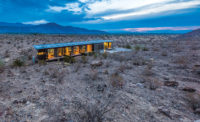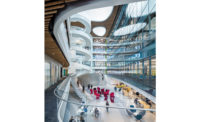Princeton, New Jersey
At Princeton University's new Frick Chemistry Laboratory, dedicated in April, a highly efficient lighting scheme is one of several tightly integrated strategies that contribute to the building's ambitious energy-saving goals: Frick is designed to use 24 percent less site energy than allowed by the 2007 version of ASHRAE 90.1 standard.
This building's configuration is a product of both environmental and programmatic goals, according to its architects, London-based Hopkins and Payette Associates of Boston. The 265,000-square-foot structure has two four-story, largely glass-enclosed wings'one on the east for research and another on the west for offices. The pieces are joined by a 75-foot-tall, skylit atrium topped with photovoltaic panels that provide shading in addition to generating electricity. Along with its transparency, the scheme promotes connectivity between individual elements and interaction among occupants, says Robert Schaeffner, Payette principal.
The research wing, organized as repeating modules with lab benches at the center and an open zone for circulation and study carrels at the perimeter, has an average connected lighting load of 1.25 W/square foot'a level that is about 11 percent below the code allowance, says Christopher Rush, senior lighting consultant in the New York office of Arup. Designers provided the required illumination over lab benches while keeping lighting power densities low, with direct lighting fixtures housing T5 lamps. The luminaires, positioned so that researchers will not cast shadows over their own work surfaces, are attached to a raceway suspended below exposed ductwork and other mechanical equipment'a strategy that allowed the project team to place fixtures wherever they were needed and omit them where not. This trunk system should also make it easier for facility managers to move the fixtures if lab equipment is rearranged at a later date.
The lighting in this central zone is controlled by occupancy sensors, but is not connected to daylight dimmers. This differs from the scheme at the perimeter, where indirect pendant fixtures, activated by both daylight dimming and occupancy sensors, bounce light off an uncluttered suspended ceiling. Occupants can control task lights in the study carrels lined up along the glazed wall between the laboratory and the atrium and along the east-facing exterior curtain wall. Here, fixed aluminum shading devices mitigate heat gain and glare. Manually operated interior roller blinds provide additional protection.
People |
Products |







